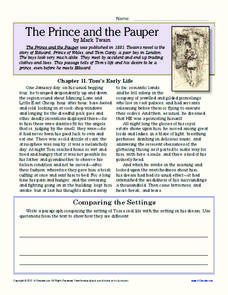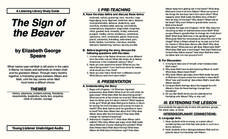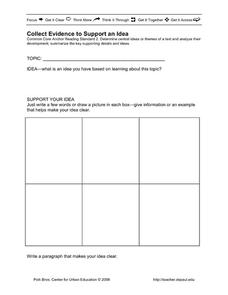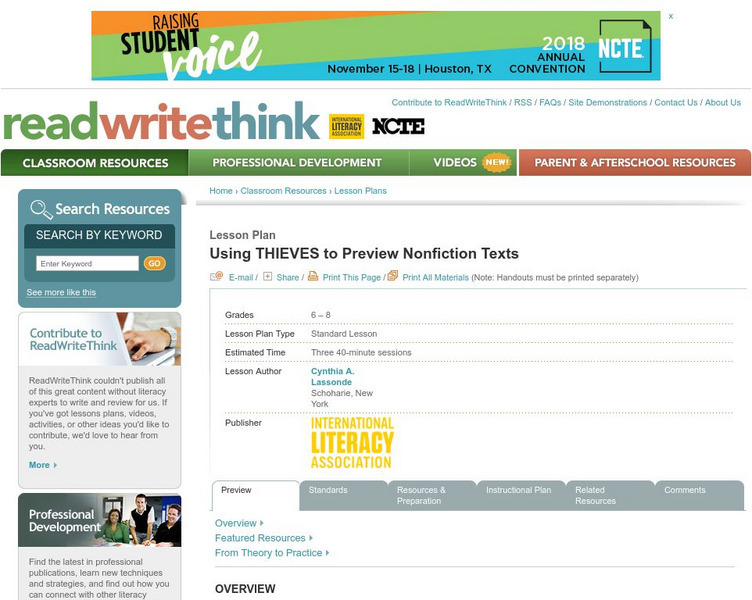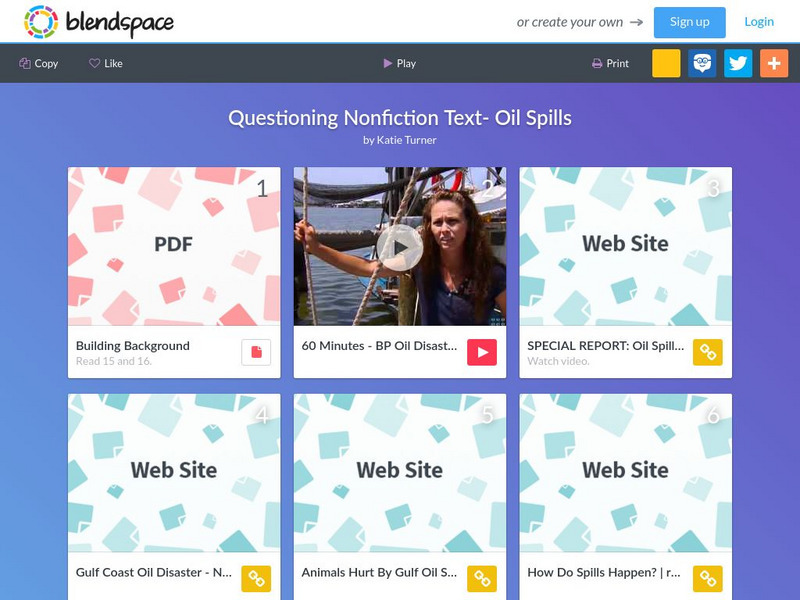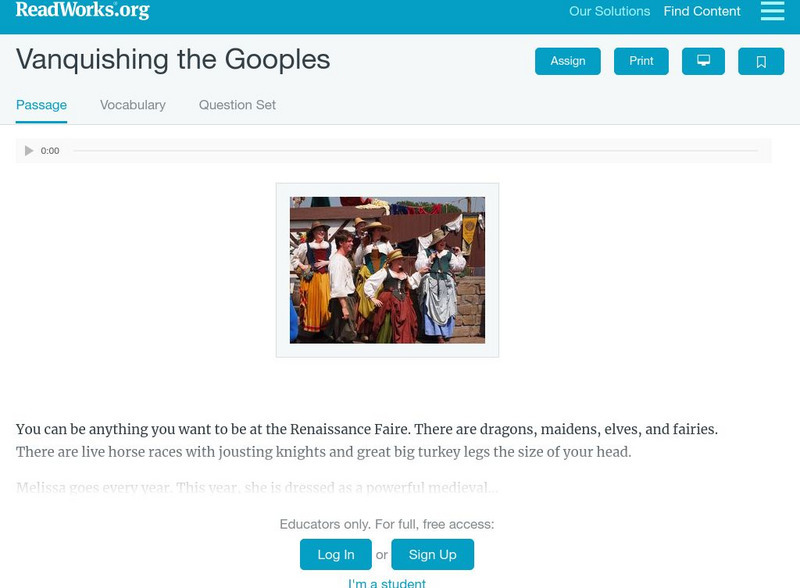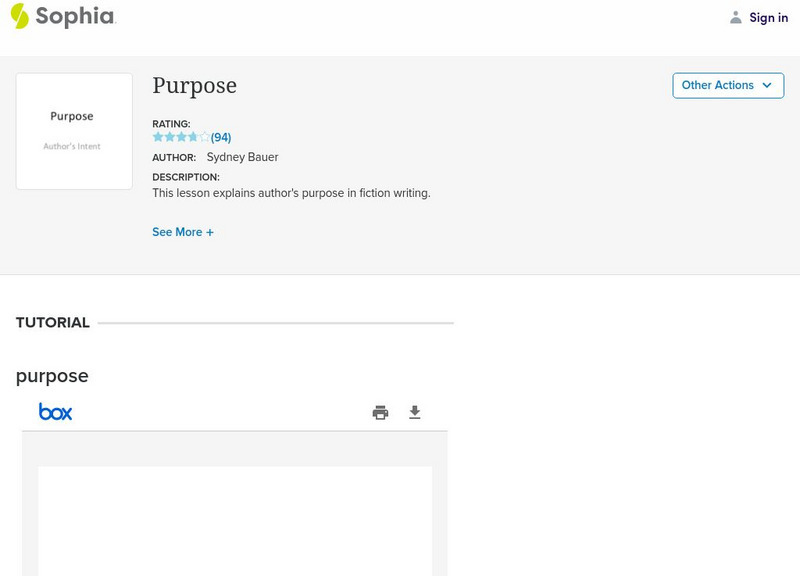Curated OER
The Boy in the Striped Pajamas: Anticipation Guide
Let your learners voice their opinions on morals and human rights with an anticipation guide for Asa Butterfield's The Boy in the Striped Pajamas. Before reading the novel, kids read several statements that encourage them to agree or...
K12 Reader
The Prince and the Pauper
A passage from Mark Twain's The Prince and the Pauper provides readers with a chance to demonstrate their ability to select evidence that shows the contrasts between the setting of Tom's real life and that of his dream life.
Listening Library
The Sign of the Beaver
Extend a class reading of the novel The Sign of the Beaver across all subject areas with this literature unit guide. From basic discussion questions and writing prompts, to a research project about tracking animals, this resource offers...
Polk Bros Foundation
I Can Infer the Main Idea When I Read
While reading any text, ask your pupils to keep this graphic organizer on hand. They can note down the main idea and three supporting details during or after reading. The instructions allow for individuals to use words or images to...
Polk Bros Foundation
Show, Then Write What You Learn
After reading a text or covering a new topic, have class members fill out the four boxes on this page with facts. Individuals can use words or drawings to represent the facts.
Polk Bros Foundation
Picture the Main Idea
Invite your learners to represent the central idea of a text visually. Individuals note down the main idea and then have the opportunity to draw four pictures that show the idea. Consider working out the main idea together and then...
Polk Bros Foundation
I Can Analyze a Story or History Completely and Carefully
Start off analysis of a text with a worksheet that asks pupils to complete several tasks. Class members note down a couple of characters or people and their distinguishing traits, describe the most important event, summarize the text...
Polk Bros Foundation
I Can Comprehend a Paragraph, then a Page/Section in a Text
Help your class tackle chunks of text with a simple graphic organizer. Pupils read three paragraphs and, as they read, draw pictures in the provided boxes that demonstrate what each paragraph says. There are three boxes on the page and...
Polk Bros Foundation
Collect Evidence to Support an Idea
In order to support an idea, writers must use evidence. Your class members can prepare their evidence with this basic worksheet. Writers note down the topic they are learning about and their own idea. Next, they come up with information...
Polk Bros Foundation
Main Idea Analyzer
Show the connection between the main idea and supporting details with a graphic organizer. Pupils fill in the main idea of a text in the circle and the supporting ideas in the boxes connected to the circle.
Curated OER
Design a Book Cover
Class members take on the role of graphic designer and craft a cover for a book they are reading. Individuals formulate a proposal outlining the images they will use to not only grab the interest of readers, but hint at the mood and...
PBS
Pbs Learning Media: Walmart Middle School Litercy Initiative
Interactive, student-paced lessons on such literacy skills as categorizing, comparing and contrasting, summarizing, evaluating, determining cause and effect, using text features, connecting, inferring, sequencing, understanding problems...
E Reading Worksheets
E Reading Worksheets: Text Structure Practice 1
This interactive learning exercise provides 10 questions: each includes a reading passage which students read and select the patterns of organization used in each passage. RI.11-12.3 Text development
Polk Brothers Foundation Center for Urban Education at DePaul University
De Paul University: Center for Urban Education: Nonfict Readers Analyze Structure/views[pdf]
This graphic organizer contains questions for students as they analyze any nonfiction text. Students will read closely to determine the text's structure, viewpoint, and tone. This graphic organizer is a copyrighted material that may be...
Polk Brothers Foundation Center for Urban Education at DePaul University
De Paul University: Center for Urban Education: History Thinker: Analyze Then Summarize [Pdf]
This Center for Urban Education resource provides a downloadable worksheet. Students will read about a historical event and answer scaffolded questions that will help them retell what happened, explain the causes and effects, and then...
ReadWriteThink
Read Write Think: Using Thieves to Preview Nonfiction Texts
Contains plans for three lessons that introduce a nonfiction prereading strategy with the acronym THIEVES, which stands for Title, Headings, Introduction, Every first sentence, Visuals and vocabulary, End Questions, and Summary. In...
ReadWriteThink
Read Write Think: Expository Escapade: Detective's Handbook
Working on higher-level thinking skills with your readers is made easier with this lesson. You will have your students connect with and analyze a mystery story at their grade-appropriate level. Lesson plan, printable worksheets, and...
ReadWriteThink
Read Write Think: Playing With Genre Through Newspapers and Short Stories
Contains plans for three lessons that ask students to compare narrative writing (short stories) to expository writing (news articles) in order to understand what makes each genre unique. In addition to objectives and standards, this...
Other
Academic Reading: Sample Task [Pdf]
This Academic Reading task provides a practice assessment for identifying headings and subheadings. In the task, students must read the selection and then determine the best subheading for each of the sections.
TES Global
Blendspace: Questioning Nonfiction Text Oil Spills
An eight-part learning module with links to texts, videos, and websites to use while improving informational text skills through the topic of oil spills. The print materials have directed exercises for text analysis by students.
Read Works
Read Works: Passages: Vanquishing the Gooples
[Free Registration/Login Required] Students read a story about a girl named Melissa and her adventure at a Renaissance Faire and answer questions in comprehension, setting, characterization, main idea, inference, transitions, and more. A...
Annenberg Foundation
Annenberg Learner: Literature: Describing Setting
Short explanation of setting as a literary term. Written in the context of "What makes a good short story?" A link at the bottom of the page leads to additional information about setting.
Sophia Learning
Sophia: Purpose
This slideshow lesson focuses on purpose; it defines purpose and lists the two main purposes of all writing: to educate (didactic text meaning to inform and instruct) or to entertain (imaginative text). The purpose could also be art for...
Sophia Learning
Sophia: Selecting Topics for Literary Analysis
A series of resources designed to teach students how to write a literary analysis. The first is a screencast [6 mins] that focuses on defining and introducing the parts of a literary analysis. The second is a slide show with seven slides...



